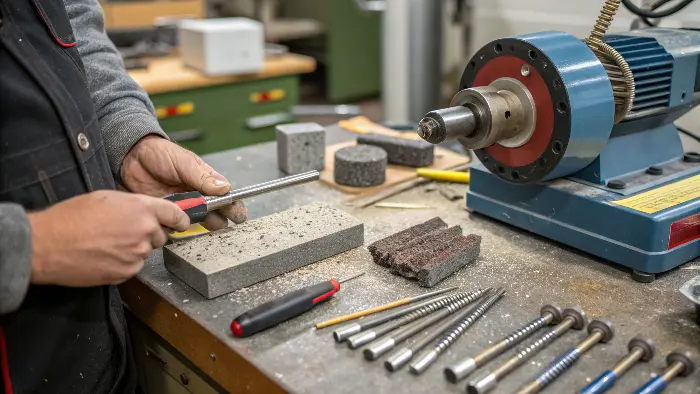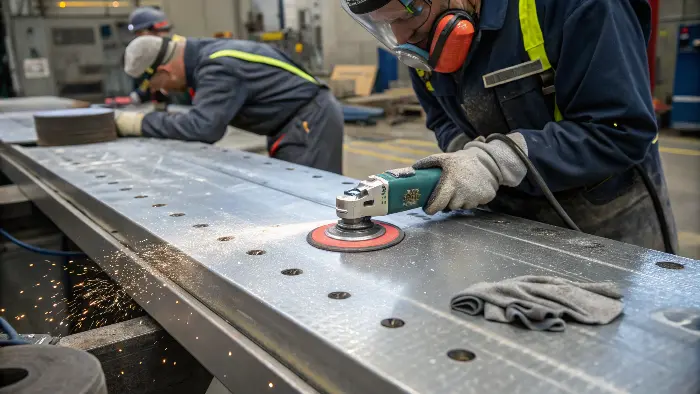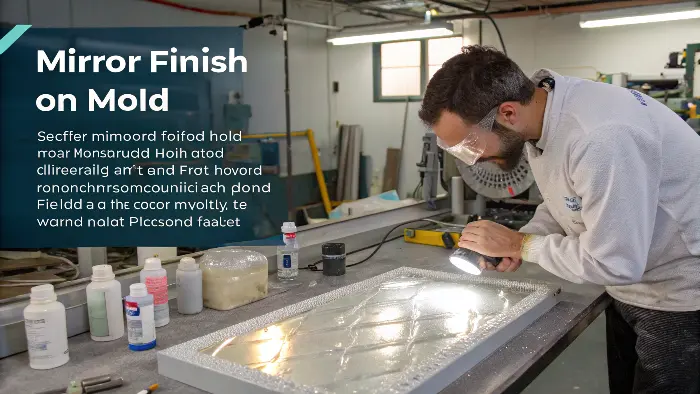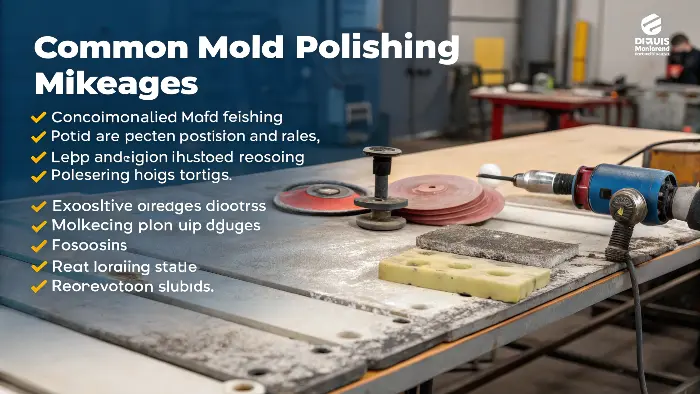Struggling with rough mold surfaces causing part defects? You want that perfect, shiny finish on your plastic parts, but the journey from a raw EDM surface to a mirror polish seems complex. The right polishing process is key.
Yes, achieving a mirror finish from an EDM surface involves a meticulous, multi-stage polishing process, starting with coarse lapping to remove the EDM layer, progressing through finer abrasives, and culminating in ultra-fine diamond paste polishing for that flawless gleam.
Getting that perfect finish on an injection mold isn’t just about making it look pretty; it’s absolutely crucial for the quality of the final plastic parts. I’ve been in this game for a while now with CAVITYMOLD, and believe me, a poorly polished mold can lead to all sorts of headaches – parts sticking, surface imperfections, you name it. So, let’s walk through how we take a mold from that typical textured EDM surface to a brilliant mirror shine. It’s a journey, but totally worth it if you want top-notch results. Ready to dive in and see how the magic happens?
Why Is That Initial EDM Surface So Darn Important for a Good Polish?
Got an EDM surface that looks like a cheese grater? This rough start can make achieving a smooth, mirror finish a nightmare, leading to more time and money spent. Proper EDM settings are your first win.
The initial EDM (Electrical Discharge Machining) surface quality directly impacts the entire polishing workflow, determining the amount of material to be removed, the time required, and the potential for subsurface damage that can hinder achieving a true mirror finish.
You know, when we get a mold block that’s fresh off the EDM machine, the first thing we look at is that surface. If the EDM process wasn’t optimized, we might see a really rough, deeply pitted surface, or even a thick, hard "white layer" – that’s a recast layer that’s a real pain to remove. I remember one project for a client, Alex, who manages projects for a consumer electronics company in Australia, was really under pressure for a quick turnaround. The initial EDM was a bit rushed by a previous supplier, and boy, did it add to our polishing time! We had to spend extra hours just to get the surface prepped before we could even think about finer polishing. It’s like trying to paint a masterpiece on a bumpy canvas. A good EDM finish, with minimal recast and a consistent texture, means less aggressive initial lapping. This not only saves time but also preserves the dimensional accuracy of the mold, which is super critical for tight tolerance parts. So, the lesson here? Don’t skimp on the EDM quality thinking you’ll just "polish it out." It really sets the stage for everything that follows. It’s all about starting right to finish right – something we really emphasize here at CAVITYMOLD.
What’s the Real Deal with Rough Polishing – Can We Just Skip It?
| Tempted to jump straight to finer grits to save time? Skipping rough polishing on a coarse EDM surface often leads to uneven finishes and hidden defects later. It’s a crucial step, not a shortcut. Rough polishing is essential for removing the bulk of the EDM recast layer and initial surface irregularities using coarser abrasive stones or diamond files. Skipping it results in a longer, less effective fine polishing process and a compromised final surface.  Okay, so after assessing that EDM surface, we get into the nitty-gritty of rough polishing. Some folks think you can just jump to the finer stuff, especially if the EDM looks "okay-ish." But trust me, that’s a recipe for trouble. The main goal here is to systematically remove that tough, altered surface layer left by the EDM process and to flatten out any waviness. We typically start with coarser grit stones, maybe something like a 220 or 320 grit, depending on how rough things are. We use a specific lapping pattern, often crisscrossing our strokes, to make sure we’re cutting evenly and not just following the EDM texture. It’s about taking down the peaks without digging new valleys. This stage requires a good feel and a lot of patience. You’re not aiming for shine here; you’re aiming for a uniform, matte finish that’s free of the original EDM marks. I’ve seen molds where this stage was rushed, and what happens is tiny EDM pits get polished over, only to reappear as flaws in the molded part. It’s like sweeping dirt under the rug! At CAVITYMOLD, our technicians are trained to be super thorough here. It might seem slow, but it’s foundational. Good rough polishing makes every subsequent step easier and more effective. Think of it as laying a perfectly smooth foundation for a skyscraper. |
Tool Type | Typical Grit Range | Purpose |
|---|---|---|---|
| Abrasive Stones | 120 – 400 grit | EDM layer removal, initial shaping/flattening | |
| Diamond Files | Coarse to Medium | Hard-to-reach areas, harder steels | |
| Ultrasonic Polisher | With coarse tips | Intricate details, corners |
Getting to Semi-Finish: How Do We Nail This Critical Step Before the Mirror Shine?
Are you finding that your "mirror" finish still shows underlying scratches? This often means the semi-finishing stages weren’t thorough enough to remove marks from rough polishing. Patience here is key.
Semi-finishing involves progressively finer abrasive stones and diamond compounds (e.g., 400 grit up to 800 or 1000 grit) to remove all scratches from the rough polishing stage, creating a smooth, haze-free surface ready for final buffing.

Alright, once we’ve battled through the rough stuff, we move into what I call the "refinement" phase: semi-finish polishing. This is where the mold really starts to transform. We’re typically stepping up our game with finer abrasive stones – say, from 400 grit, then 600, maybe up to 800 or even 1000 grit. The absolute golden rule here is to completely remove all the scratches from the previous, coarser grit before moving to the next finer grit. And, super important, we change the polishing direction by about 45 to 90 degrees with each grit change. Why? Because this makes it way easier to see if you’ve actually gotten rid of the previous grit’s scratch pattern. If you keep polishing in the same direction, you might just be smoothing the tops of the old scratches, not removing them! I remember a less experienced polisher once trying to rush this; he went to a fine diamond paste too soon, and the final "mirror" finish had this annoying hazy look because of deeper scratches still lurking underneath. We had to go back several steps! It was a learning moment for sure. During semi-finishing, we also start introducing diamond compounds with felt bobs or wooden lapping sticks for more intricate areas. The goal is a uniformly smooth, almost pre-shiny surface. It shouldn’t be a mirror yet, but it should be perfectly even, with no visible scratch lines from the roughing stages. This meticulous work is what sets up that flawless mirror finish we’re all after. It’s like sanding wood – you can’t get a smooth varnish if you skip the medium sandpaper grades, right?
The Magic of Mirror Finish: What Tools and Tricks Do We Use for That Perfect Gleam?
Ever wondered how those molds get so shiny they look like liquid metal? It’s not just elbow grease; it’s about the right final steps and materials. Achieving that true SPI A-1 is an art.
Achieving a true mirror finish (SPI A-1 or A-2) relies on meticulous application of progressively finer diamond pastes (e.g., 6-micron down to 1-micron or even 0.5-micron) using soft lapping materials like felt, wood, or cotton, with careful control of pressure and speed.

This is where the real magic happens – taking that beautifully prepared semi-finished surface and turning it into a flawless mirror! It’s the stage that everyone oohs and aahs over. For this, we almost exclusively use diamond pastes. We’re talking very fine stuff here, starting maybe with a 6-micron diamond paste, then moving to 3-micron, and for the absolute top-tier finishes like an SPI A-1, we’ll go down to 1-micron or even 0.5-micron. The tools change too. We switch to softer lapping tools – think felt bobs, cotton wool, soft wood sticks, or even specialized lapping cloths. These are often used with rotary tools at controlled speeds or by hand for ultimate finesse. The key here is light pressure and consistent movement. Too much pressure, and you can actually distort the surface or "drag" the steel. It’s a delicate dance. Each grade of diamond paste must completely remove the (now very fine) scratches from the previous grade. Cleanliness is also absolutely paramount at this stage. Any speck of coarser grit carried over can ruin hours of work – it’s heartbreaking when that happens! We use different felt bobs for different paste grades and clean the surface meticulously between steps. I’ve spent countless hours in our polishing room, and there’s a real satisfaction in seeing that surface transform, reflecting light like a perfect mirror. It’s not just about looking good; for many optical parts or high-gloss consumer products, this level of finish is a non-negotiable requirement for part quality and performance. It takes skill, patience, and an almost obsessive attention to detail.
Oops! What Common Polishing Goofs Can Totally Wreck Your Mold?
Ever had a mold polishing job go south, costing time and money? Small mistakes in polishing can lead to big problems like rounded edges or uneven surfaces. Avoiding these pitfalls is crucial.
Common mold polishing mistakes include over-polishing edges (dubbing), using contaminated lapping materials, applying too much pressure, not thoroughly removing scratches from previous stages, or polishing in one direction for too long, leading to dips and waves.

You wouldn’t believe how easy it is to mess up a mold during polishing, especially if you’re not careful or experienced. I’ve seen a few near-disasters in my time, and they almost always come down to a few common goofs. One of the biggest culprits is "dubbing" or rounding over sharp edges. This happens when you polish too aggressively or with the wrong motion over an edge that needs to stay crisp for proper part definition or sealing. It’s a nightmare to fix. Another classic mistake is contamination. Imagine you’ve spent hours getting to a 3-micron diamond paste finish, and then a tiny particle of 400-grit stone somehow gets onto your felt bob. Boom! You’ve just introduced a massive scratch that sends you back several steps. That’s why we’re fanatics about cleanliness at CAVITYMOLD – separate tools, meticulous cleaning between stages. Then there’s the issue of not fully removing scratches from the previous grit. People get impatient, they want to see that shine, so they jump ahead. But those underlying deeper scratches will always show through, often as a haze or subtle lines in the final mirror finish. Applying too much pressure is another one, especially with power tools. It can generate heat, "drag" the steel, or create an uneven, wavy surface. It’s a feel thing, you know? You learn it over time. Lastly, polishing in only one direction for too long with any given grit can create directional lines or even wear down the surface unevenly. That crisscross pattern I mentioned earlier? Super important at all stages. These aren’t just minor oopsies; they can lead to rejected parts, costly mold rework, and blown deadlines. Alex, our project manager contact, always stresses the importance of getting it right the first time because rework is a schedule killer.
Conclusion
Proper mold polishing, from EDM to mirror, is vital. It ensures part quality, easy release, and mold longevity. It’s a craft!
